Air pollution also causes morbidity, whereby people live with disease, resulting in personal suffering as well as significant costs on the health care sector. In 2019, exposure to PM2.5 led to 175,702 years lived with disability (YLDs) due to chronic obstructive pulmonary disease in 30 European countries. At the same time, exposure to NO2 led to 175,070 YLDs due to diabetes mellitus (also known as Type 2 diabetes) in 31 European countries. That same year, 12,253 people across 23 European countries were admitted to the hospital with lower respiratory infections resulting from acute exposure to ozone (EEA, 2022b).
Air pollution is not just detrimental to health: it also leads to significant economic costs. A 2020 study estimated the health-related social costs of air pollution in cities of 30 European countries (the EU-27 plus Norway, Switzerland and the United Kingdom) to be over EUR166 billion in a single year, 2018. It was estimated that European city dwellers suffered an average welfare loss of over EUR1,250 a year, equivalent to 3.9% of income. There were significant differences across Europe, with costs amounting to between 8% and 10% of income earned in cities in Bulgaria, Poland and Romania. Most of these costs relate to premature mortality (76%), with a smaller proportion (24%) related to morbidity (illness) (CE Delft, 2020).
A number of additional pollutants, such as black carbon, are not covered by current EU air policies and monitoring frameworks but may pose a threat to health, as explained in the zero pollution ‘Signal’ on emerging pollutants. For example, in its 2021 air quality guidelines, WHO identifies evidence of health impacts from exposure to black carbon, ultrafine particles and sand dust storms (WHO, 2021).
People’s health may also be affected by indoor air pollution (see zero pollution ‘Signal’ on indoor air quality), particularly given that people spend up to 90% of their time indoors (Vardoulakis et al., 2020). Workplaces can also be a significant source of exposure to pollutants, as explored further in the health and chemicals section.
Progress towards zero pollution — fine particulate matter
The zero pollution action plan sets the target of improving air quality, with a focus on fine particulate matter (PM2.5), as this pollutant is responsible for the majority of premature deaths caused by air pollution in the EU. Meeting the target requires a minimum 55% reduction in premature deaths by 2030, relative to 2005 levels (EC, 2022a). The EEA estimates that 431,000 premature deaths were attributable to exposure to PM2.5 in 2005 in the EU-27 (EEA, 2022d). Achieving a 55% reduction would require that premature deaths fall to 194,000 per year.
From 2005 to 2020, premature deaths attributed to PM2.5 fell by 45% (see Figure 5) in the EU-27. This is primarily because less emissions came from burning fossil fuels and pollution abatement equipment was introduced across the industry and road transport sectors (for example). Should air quality continue to improve, and the number of premature deaths per year continue to fall at a comparable rate, then the target will be achieved before 2030.
To meet the target, Member States will need to fully implement their national air pollution control programmes, as well as measures needed to reach the 2030 climate and energy targets (EC, 2022b). However, the upwards trends in ageing and urbanisation in Europe counteract some of the health gains associated with reducing ambient air pollutant concentrations. Specifically, older populations are more sensitive to air pollution (see zero pollution ‘Signal’ on vulnerable groups) and a higher rate of urbanisation typically means that more people are exposed to high PM2.5 concentrations.
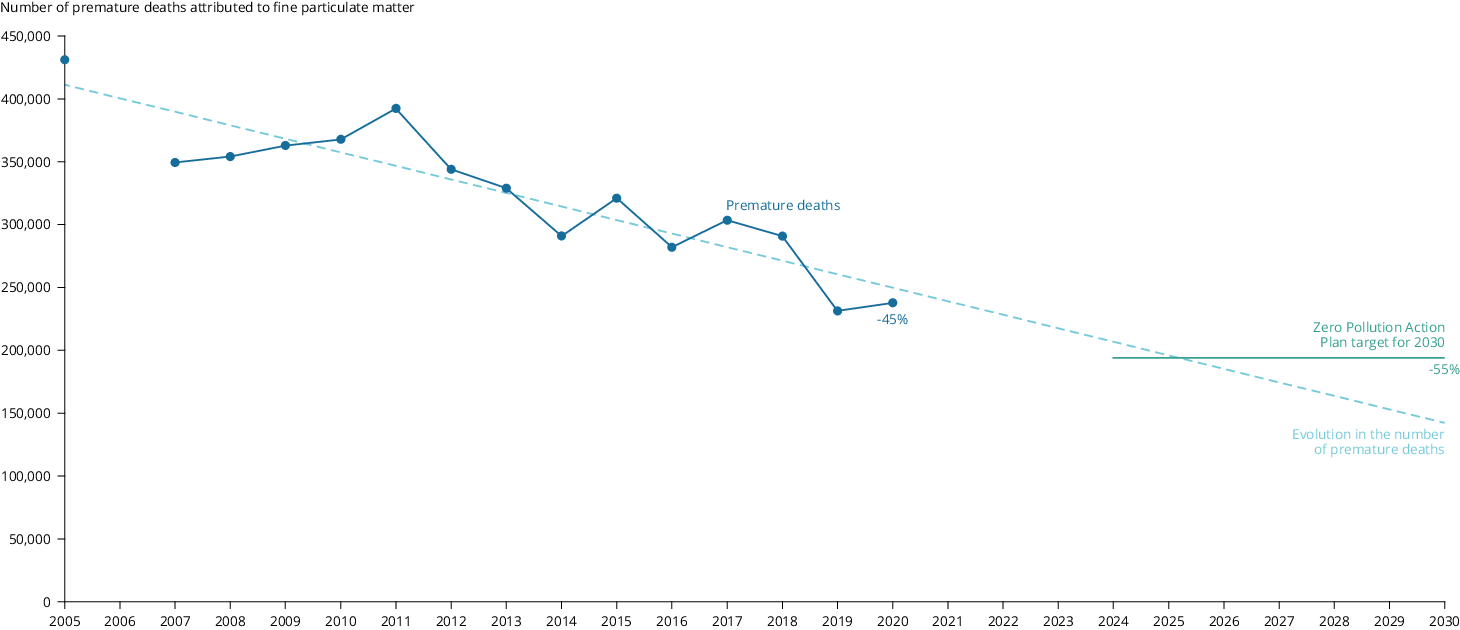
Source: EEA, 2022d.
Click here to view the figure enlarged
Click here for different chart formats and data
Urban exposure to air pollution
In 2020, the vast majority of the EU’s urban population was exposed to levels of key air pollutants that are damaging to health. In particular, 96% of the urban population was exposed to concentrations of PM2.5 above the WHO guideline value of 5µg/m3.
Figure 6 shows the percentage of the urban population exposed to air pollutant levels higher than those outlined in both the EU standards and the WHO guidelines. It also highlights the difference between these values, that is, how much less stringent the EU standards are than the latest guideline values set by WHO to protect health. Bringing the EU’s PM2.5 limit closer to the WHO guidelines would deliver significant health benefits. Overall, closely aligning EU air quality standards with the WHO recommendations would represent an important step towards cleaner air in Europe in line with the long-term zero pollution ambition.
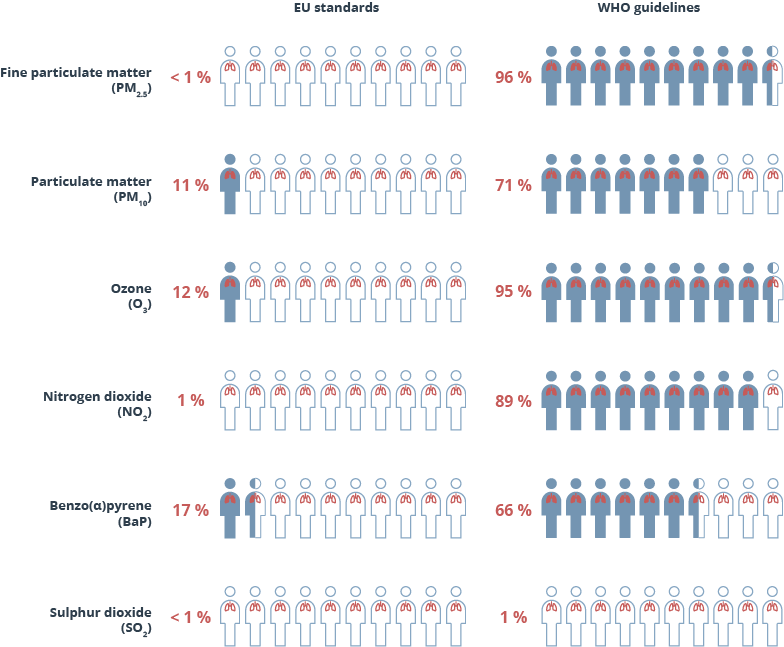
Source: EEA (2022e).
Inequity in exposure to air pollution
The impacts of air pollution are not evenly distributed across society. Clear evidence links lower socio-economic status to higher exposure to air pollution (EEA, 2018). In large parts of Europe, poorer people are more likely to live next to busy roads or industrial areas and face higher levels of exposure to pollution. In addition, the most deprived people in society often have poorer health and less access to high-quality medical care, increasing their vulnerability.
Figure 7 presents trends in concentrations of PM2.5, weighted by population, of the most disadvantaged regions and the least disadvantaged regions in terms of gross domestic product (GDP) per capita. While air quality has improved in both the wealthiest regions and the poorest regions, a gap remains between the two. Air pollutant concentrations fell by 36% in the wealthier regions from 2009 to 2019 — faster than in the poorer regions, where the decrease was only 25%.
Figure 7. Trends in population-weighted average annual concentrations of PM2.5 in the most disadvantaged and least disadvantaged quintiles of EU-27 NUTS 3 regions, 2007-2019
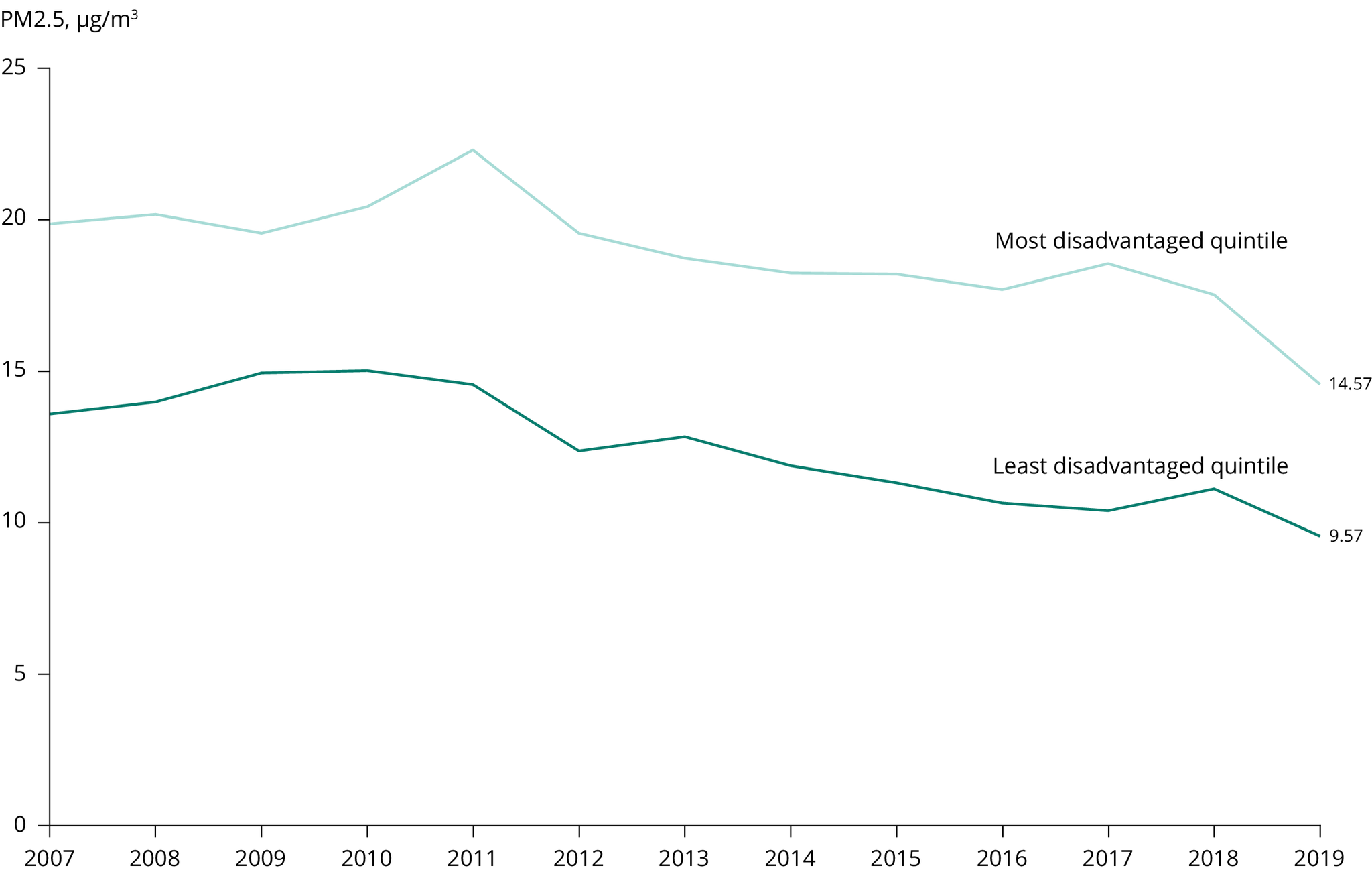
Note: Most disadvantaged and least disadvantaged quintiles are based on Eurostat data on GDP per capita. Nomenclature of Territorial Units for Statistics (NUTS) 3 regions are from Eurostat’s Geostat 2011 population grid data set. Population-weighted concentrations are based on an EEA analysis of interpolated annual statistics of reported monitoring data from 2018.
Sources: EEA (2022f) for air quality data and Eurostat (2022) for GDP data.
Click here for different chart formats and data
Other air pollutant concentrations in outdoor air
While the EEA Air Quality Report (2022f) reveals that air quality has improved significantly since 2005, exceedance of EU standards is a continuing trend across Europe. Concentrations of most pollutants are also well above WHO guidelines in almost all Member States (EEA, 2022b). For PM10, PM2.5, NO2 and benzo[α]pyrene (BaP), the percentage of EU monitoring stations reporting exceedances is declining. On the other hand, SO2 concentrations are marginally increasing. Concentrations of O3 are strongly influenced by temperature; as a result, there is significant interannual variation in exceedances.
To assess air quality, monitoring is normally undertaken at fixed stations and complemented by modelling — with data reported to the EEA and made publicly available. Recently, using simple, low-cost devices to measure local air pollution levels through citizen science initiatives has become popular, as explained in the zero pollution ‘Signal’ on new approaches to assessing air quality. In the near future, citizen science initiatives coupled with new data digitalisation approaches may lead to a paradigm shift in the way that air quality is assessed. Rather than relying on a single monitoring station to measure impacts for a large number of people, combining these two unique approaches would enable a more accurate assessment of air quality.
Note: Links to indicators: Exceedance of air quality standards in Europe, Health impacts of exposure to fine particulate matter in Europe.
Overview of indicator analysis methodology
This indicator analysis is in line with the approach taken by the EEA for its seventh environment action programme monitoring.
Past trends are based on assessment of the trend over the last 10 years (or since the relevant zero pollution baseline year where appropriate) with green, yellow or red being applied based on the criteria as outlined in the figure legend. Expert judgement is also applied, for example in cases where indicators are more qualitative and/or uncertain.
The distance to target is based on an assessment of the recent trend, current status and expert judgement.
Further detailed analysis of the future outlook for meeting certain zero pollution targets is included in the zero pollution outlook 2022, completed by the European Commission Joint Research Centre (JRC, 2022).
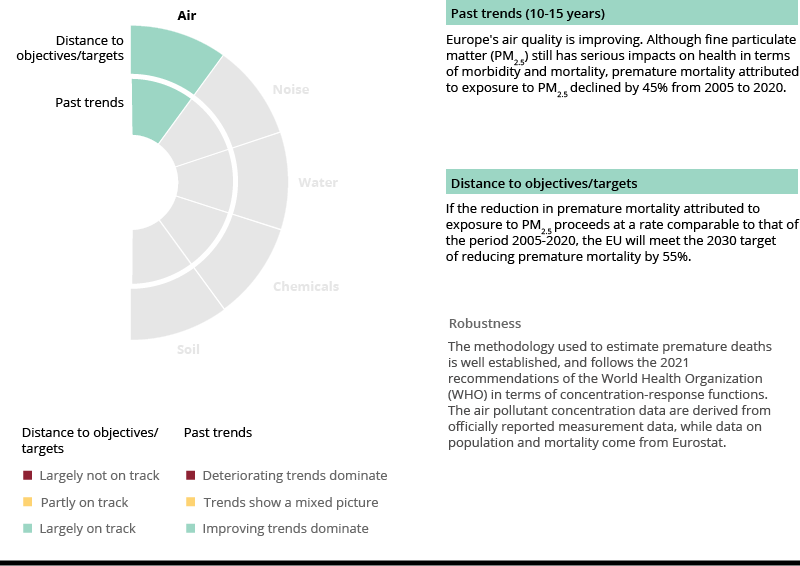
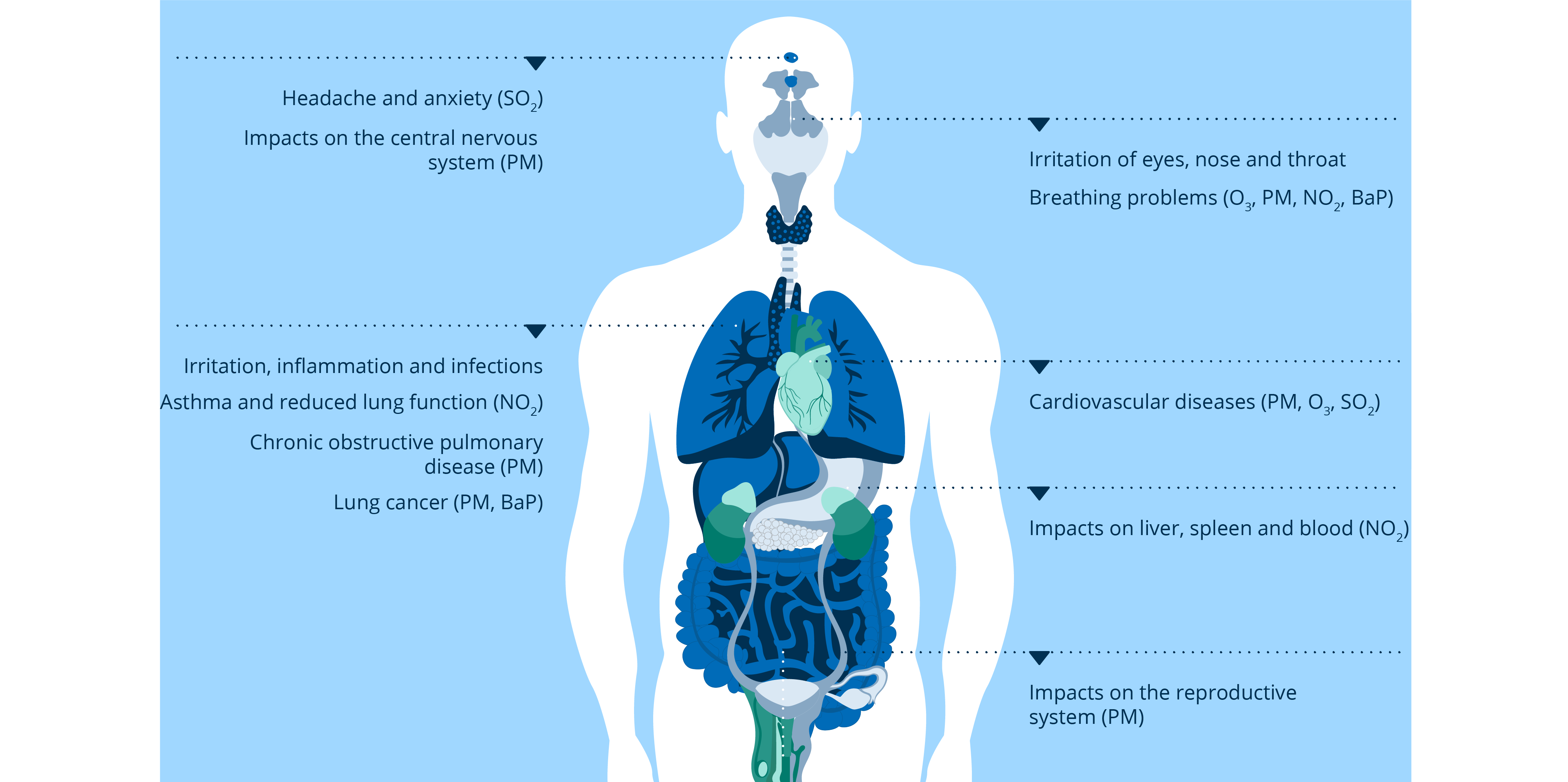



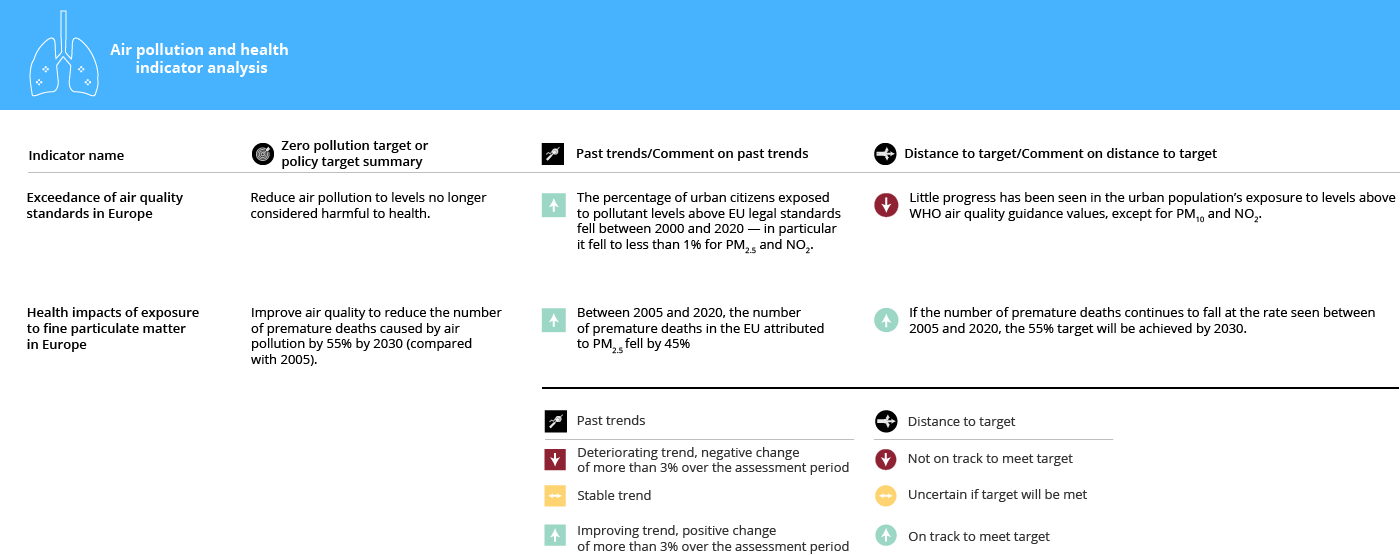
Document Actions
Share with others